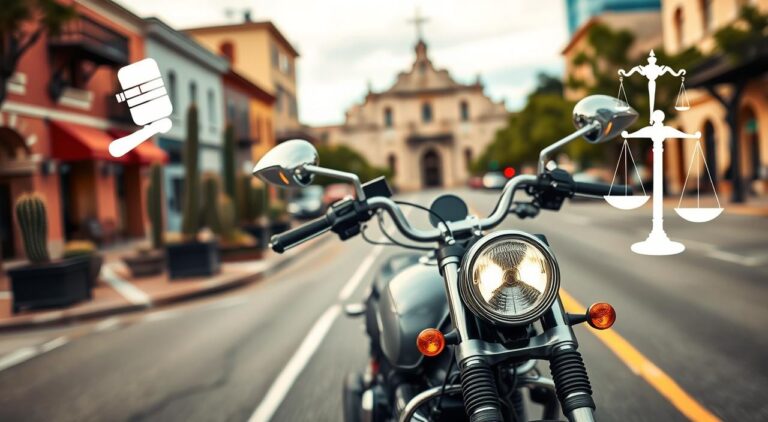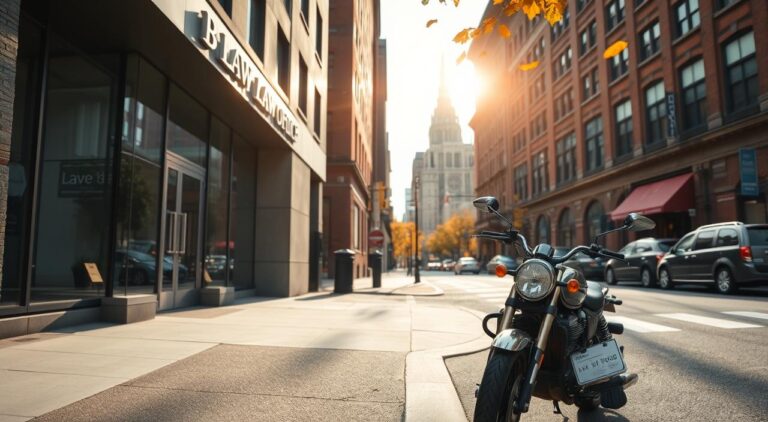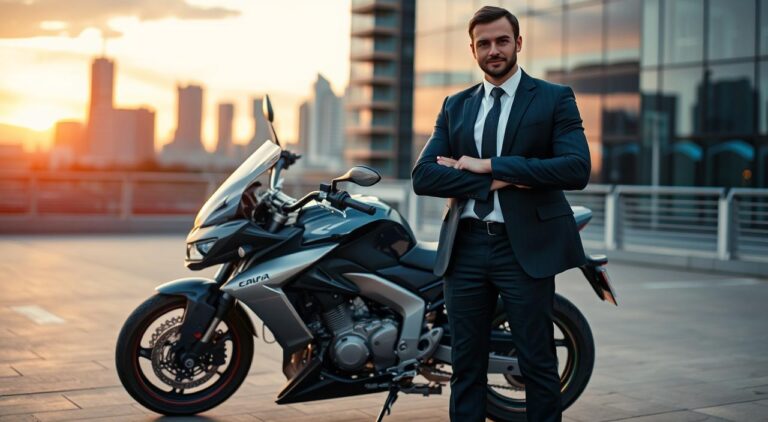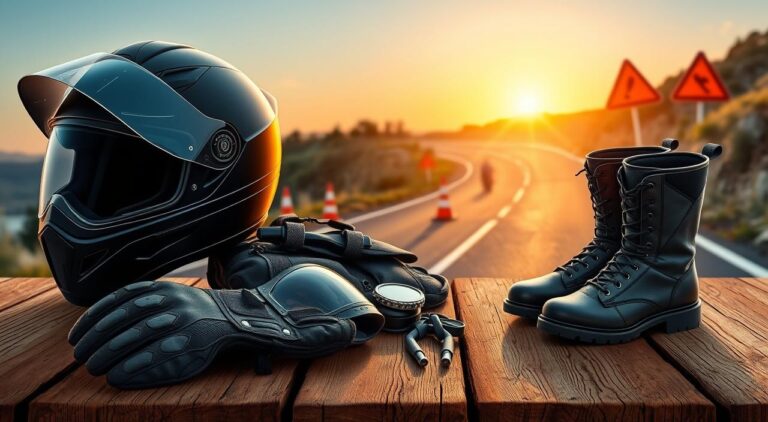Riding a motorcycle is thrilling, with the wind rushing past you. But, it comes with risks. A motorcycle crash can happen fast, changing lives in unexpected ways.
If you ride a motorcycle, knowing the risks is key. This guide will help you understand what causes crashes and how to stay safe. You’ll learn about protective gear and training, so you can enjoy your rides safely.
Table of Contents
Understanding the Causes of Motorcycle Crashes
To stay safe on your bike, it’s key to know what causes crashes. Knowing these things helps you ride smarter and avoid accidents.
Common Factors Contributing to Crashes
Many things can lead to motorcycle accidents. Here are some common ones:
- Speeding – Riding too fast makes it hard to stop in time.
- Impaired Driving – Drinking or using drugs increases your crash risk.
- Inadequate Visibility – Bad lighting or weather can hide dangers.
Environmental Conditions
Knowing how the environment affects your ride is crucial. Weather, road quality, and light levels can all be dangers:
- Weather – Rain or snow makes roads slippery and raises crash risks.
- Road Conditions – Potholes or debris can cause accidents if not watched out for.
- Lighting – Poor light at dawn or dusk can hide obstacles and other cars.
Rider Behavior and Attitude
Your riding style and attitude are big factors in staying safe. Reckless riding or being inexperienced can make you more vulnerable:
- Recklessness – Taking risks and speeding can cause crashes.
- Inexperience – New riders might not know how to judge risks well.
- Ignoring Safety Practices – Not wearing protective gear can make injuries worse.
By understanding these factors, you can ride safer and make better choices on the road.
Essential Safety Gear for Motorcyclists
Wearing the right safety gear is key for motorcycle safety. It greatly lowers the chance of serious injury in an accident. High-quality gear can be the difference between a small mishap and a major event. Here are the must-have safety items for every motorcyclist.
Helmets: What to Look For
A good, DOT-approved helmet is crucial. Look for:
- Impact resistance: Make sure it meets safety standards.
- Comfort: Pick a helmet that fits well but is comfy.
- Ventilation: Good airflow keeps you cool during rides.
Protective Clothing Options
Protective clothing does more than just look good:
- Jackets: Look for ones with abrasion-resistant materials to prevent road rash.
- Gloves: They help you grip and protect your hands from impacts.
- Boots: Choose boots that protect your feet and prevent ankle injuries.
Visibility Accessories
Being seen is key to avoiding motorcycle injuries. Consider these accessories:
- Reflective gear: Reflective strips and patches make you more visible to drivers.
- Bright colors: Wearing bright clothes helps you stand out on the road.
- LED lights: Adding lights to your bike makes you more visible, especially at night.
Importance of Motorcycle Training
Getting proper motorcycle training is key to learning safe riding skills. Without it, the chance of a crash goes up. Professional training teaches you how to handle tough roads and emergencies.
Benefits of Professional Instruction
Professional motorcycle training has many benefits:
- Skill Development: Learn basic riding skills to improve your ability.
- Confidence Building: Feel more confident on your bike, reducing anxiety.
- Safety Awareness: Learn what causes crashes and how to avoid them.
Recommended Training Programs
Many trusted groups offer training programs to teach you essential skills:
| Program Name | Target Audience | Key Focus Areas |
|---|---|---|
| Basic Riders Course | Beginner Riders | Fundamentals of Riding, Safety Techniques |
| Advanced Riders Course | Experienced Riders | Refining Techniques, Handling Emergencies |
| Women’s Riding Course | Female Riders | Confidence Building, Community Support |
Continuous Skill Development
Improving your riding skills doesn’t stop after a course. It’s important to keep learning. Here are ways to keep growing:
- Additional Classes: Take advanced classes to sharpen your skills.
- Practice Sessions: Practice regularly in a safe place.
- Stay Informed: Stay updated on safety tips and techniques.
Pre-Ride Safety Checklist
Before you ride, do a thorough safety check. This can make your ride safer and prevent crashes. Check your motorcycle and get ready personally. Here are key things to look at:
Inspecting Your Motorcycle
Start by checking your motorcycle carefully. Look at these things:
- Tire Pressure: Make sure your tires are at the right pressure to avoid blowouts.
- Brakes: Test both front and rear brakes to see if they work well.
- Lights: Check that all lights, like headlights and turn signals, are working.
Checking Weather Conditions
Weather can change your ride a lot. Before you go, check:
- Visibility: Rain or fog can make it hard to see and be seen.
- Traction: Wet or slippery roads can make it hard to grip the road.
- Temperature: Cold weather can make riding uncomfortable and harder to control.
Ensuring Personal Readiness
Your physical and mental state is key for safety. Before you ride, think about:
- Fatigue: Don’t ride if you’re tired or sleepy.
- Distractions: Get rid of things that might distract you.
- Gear Check: Make sure you’re wearing the right safety gear and clothes.
Defensive Riding Techniques
Learning defensive riding techniques boosts your motorcycle safety. These skills help you deal with the unpredictable roads, lowering the risk of accidents.
Maintaining Safe Distances
It’s key to keep a safe gap from other cars. This space lets you quickly react to sudden stops or surprises. Aim for a three to four second gap behind the car in front of you.
This distance gives you time to see and act on other drivers’ moves. It’s a smart way to stay safe on the road.
Anticipating Other Drivers
Being ahead of other drivers’ moves is important. Watch for their lane changes or slowing down. Spotting these patterns helps you make quick decisions to avoid accidents.
By paying attention, you can dodge turns or lane changes. This keeps you safe and in control.
Navigating Hazards on the Road
Dealing with road hazards needs focus and quick thinking. From potholes to debris, each hazard is different. Learn how to steer around them without losing control.
Knowing how to handle uneven roads or sudden changes helps prevent accidents. It’s all about staying safe and in control.
| Technique | Description | Benefits |
|---|---|---|
| Safe Distances | Maintain a distance of three to four seconds from vehicles ahead. | Allows for timely reactions in emergencies. |
| Driver Anticipation | Observe other drivers’ behaviors to predict their actions. | Enables proactive adjustments to avoid potential collisions. |
| Hazard Navigation | Identify and skillfully maneuver around road hazards. | Reduces the likelihood of losing control or crashing. |
Legal Considerations After a Crash
After a motorcycle crash, knowing the law is key to protect you. Understanding your rights helps you deal with police and insurance companies. Reporting the accident quickly is important for any legal steps later.
Learning about insurance claims helps you get back what you lost. This includes money for injuries or damage to your bike.
Understanding Your Rights
As a motorcyclist, you have rights that protect you. Knowing these rights lets you act wisely when talking to others. You have the right to get medical help and have your damages fairly evaluated.
Reporting the Accident
It’s vital to report a motorcycle crash right away. Call the police to document the accident. This report is key for any legal or insurance claims you might make. Make sure to get a copy of the report for yourself.
Insurance Claims Process
Knowing how to file an insurance claim helps you get compensation. After a crash, collect all important info like photos and medical records. Give this to your insurance when you file a claim.
Be ready to provide the right documents to your insurer. This makes the process smoother and helps you get the money you need.
| Action | Description | Importance |
|---|---|---|
| Understanding Your Rights | Become aware of the rights you have as a motorcyclist after a crash. | Empowers you in interactions with police and insurance companies. |
| Reporting the Accident | Contact law enforcement and file a report about the crash. | Creates a record that is essential for legal and insurance purposes. |
| Insurance Claims Process | Collect evidence and file a claim with your insurance provider. | Aides in recovering damages for injuries and losses. |
The Role of Accident Reconstruction
Accident reconstruction is key in motorcycle crash investigations. Experts use various methods to break down what happened. They aim to understand the incident’s details, helping to piece together the sequence of events.
How Experts Analyze Crashes
Experts look at several things to thoroughly analyze a motorcycle crash:
- Scene analysis: They check the accident site, including road conditions and how well you could see.
- Vehicle dynamics: Where the motorcycle and other vehicles were positioned helps figure out what happened.
- Damage assessment: The damage on the motorcycle and other vehicles tells a lot about the crash’s force and angle.
Importance in Legal Cases
Accident reconstruction findings are crucial in motorcycle accident legal cases. They help make decisions on:
- Liability: They help figure out who was at fault.
- Insurance claims: They provide evidence for fair compensation for damages.
- Settlements: They support negotiations, avoiding long legal battles.
Understanding the role of accident reconstruction is vital. It can greatly impact legal outcomes after a motorcycle crash. Expert analysis leads to clearer liability and better results for those affected.
Common Injuries from Motorcycle Crashes
Knowing about common injuries from motorcycle crashes is key to staying safe. These injuries can affect a person’s health for a long time. Learning about different types of injuries helps you stay safe while riding.
Understanding Head Injuries
Head injuries are very serious from motorcycle crashes. They happen when the rider’s head hits the ground or something else. Wearing a helmet can greatly reduce the risk of brain injury.
Studies show helmets help a lot in preventing head trauma during accidents.
Road Rash and Its Treatment
Road rash happens when skin touches asphalt during a crash. It’s very painful and can cause serious skin damage and infections. To treat it, clean the area well and cover it to help it heal.
Using antibiotic ointment can prevent infections and aid in recovery.
Long-term Effects
Motorcycle injuries can lead to long-term problems like chronic pain and mobility issues. These issues might need ongoing medical care or physical therapy. Knowing this shows why it’s important to prevent injuries and wear the right gear.
What to Do Immediately After a Crash
Being in a motorcycle crash can be scary. It’s important to act fast for your safety and others. Here are some steps to take after a motorcycle accident.
Assessing Injuries
First, check if you or others are hurt. Look for injuries and ask if anyone is in pain. If someone is injured, don’t move them unless it’s dangerous. Some injuries might not be obvious, so keep watching.
Contacting Emergency Services
After checking for injuries, call for help. Dial 911 for medical help right away. Tell them where you are and how bad the accident is. Quick action can help a lot in recovery.
Gathering Evidence
Once everyone is safe and help is on the way, start collecting evidence. Take pictures of the crash, the bikes, and any damage. Get statements from witnesses and their contact info. Good evidence helps with insurance and proves what happened.
| Step | Action | Importance |
|---|---|---|
| 1 | Assess Injuries | Ensure safety and identify medical needs |
| 2 | Contact Emergency Services | Obtain immediate medical assistance |
| 3 | Gather Evidence | Build a comprehensive case for insurance |
Motorcycle Crash Statistics and Trends
It’s key to know the facts about motorcycle crashes to stay safe on the road. The data on motorcycle accidents helps you make better choices when riding.
Overview of National Statistics
Recent numbers show a worrying increase in motorcycle crashes nationwide. The National Highway Traffic Safety Administration (NHTSA) reports over 5,000 motorcycle accidents last year. This rise emphasizes the need for better safety and awareness among riders.
Impact on Insurance Rates
More motorcycle crashes mean higher insurance costs. Insurers raise rates when there’s a higher chance of claims. Riders should think about how their habits and where they ride can affect their insurance.
Trends in Motorcycle Safety
New safety tech is changing the game for motorcycle safety. Advances like better helmets, anti-lock brakes, and more make riding safer. Keeping up with these improvements can help you stay safe and reduce risks.
Resources for Motorcyclists
Finding the right resources can really help you understand motorcycle safety better. Many groups, clubs, and websites are dedicated to helping motorcyclists. These resources can boost your safety skills and connect you with other riders who love the road.
Organizations Supporting Rider Safety
Many groups focus on making riding safer through training and education. The Motorcycle Safety Foundation (MSF) is a great example. They offer courses to make riders better and reduce crashes. Other groups share safety tips, best practices, and materials for different riding needs.
Local Motorcycle Clubs and Groups
Being part of a local motorcycle club can make your rides better. These clubs host events that focus on safety and let riders learn from each other. You’ll find a community that helps you get better at riding and stay safe on the road.
Online Forums and Communities
Online forums and communities are full of useful info. They let you share experiences, get advice, and support from other riders. Talking about safe riding or sharing crash stories can make the whole riding community safer. You’ll learn a lot that can help you stay safe on your bike.
| Resource Type | Description | Benefits |
|---|---|---|
| Organizations | Non-profits focused on safety training and awareness. | Structured courses and expert guidance. |
| Local Clubs | Groups of motorcyclists promoting camaraderie and safety. | Networking opportunities and organized safety events. |
| Online Forums | Digital spaces for riders to share and learn. | Diverse experiences and advice from seasoned riders. |
Conclusion: Staying Safe on Your Motorcycle
Staying safe on your motorcycle is more than just the thrill of riding. It’s about being alert and taking steps to stay safe. By following safe riding practices and improving your skills, you can greatly reduce your chances of a crash. This effort not only keeps you safe but also promotes responsible riding for everyone.
Commitment to Safe Riding
Being committed to motorcycle safety means always checking your riding skills and gear. Spending time in professional training and workshops can make you more aware of dangers. This knowledge is crucial in avoiding crashes and making your rides safer.
Continuous Education and Awareness
For motorcyclists, never stop learning. Whether it’s through classes or self-study, knowing more about motorcycles and road safety is vital. Keeping up with new safety tips, risks, and tech can make you more aware and ready for anything.
Encouragement to Share Knowledge
Sharing what you know with other riders is also important. A community focused on safety can lead to better riding and fewer crashes. By talking openly and promoting safe habits, you help make the roads safer for all.
FAQ
What should I do if I am involved in a motorcycle crash?
First, check if you’re hurt and make sure you’re safe. Call for help right away. Take photos and get statements from witnesses.
Exchange info with others involved. Tell your insurance about the crash to start your claim.
How can I prevent motorcycle accidents?
Ride safely by keeping a safe distance and watching out for others. Wear a helmet and protective clothes. This can help a lot if you crash.
Take a motorcycle course and check your bike before you ride. It’s important for safety.
What are common injuries associated with motorcycle crashes?
You might get head injuries, road rash, or broken bones. Wearing the right gear and knowing the risks can help.
What should be included in a pre-ride safety checklist?
Check your bike’s tires and brakes. Make sure your lights and fluids are good. Also, check the weather and how you’re feeling.
How does motorcycle training improve safety?
Training teaches you how to ride safely. You learn about dangers and how to avoid them. It makes you more confident and careful.
What is the importance of accident reconstruction after a motorcycle crash?
It helps figure out what happened in the crash. Experts use different methods to understand the accident. This is key for legal cases and insurance claims.
What are the legal steps I should follow after a motorcycle accident?
Know your rights and report the crash to the police. Take photos and get witness statements. Tell your insurance right away.
Get legal advice if you need to.
How can I stay informed about motorcycle safety trends?
Follow groups like the Motorcycle Safety Foundation. Join local clubs for safety tips. Online forums are great for sharing tips and experiences.
What role does visibility play in motorcycle safety?
Being seen is key to safety. Wear reflective clothes and use bright colors. Make sure your bike’s lights work well, especially at night.
What common mistakes lead to motorcycle accidents?
Speeding, riding drunk, ignoring signals, and not yielding are big mistakes. Knowing these can help you avoid accidents.
[hurrytimer id=”503″]












